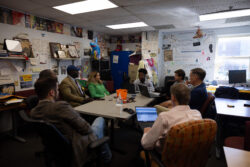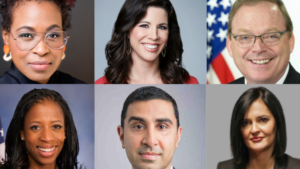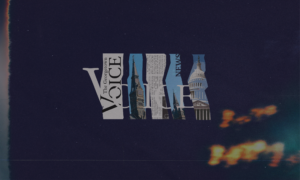Georgetown alumni Scott Conroy (COL ’05) and Peter Hamby (COL ’03), co-creators of the sitcom Embeds, discussed their experiences covering the 2008 presidential campaigns as embedded reporters during the Institute of Politics and Public Service’s Jan. 30 event “Embeds: Reporters Revitalizing Political Journalism.”
The event featured six clips from the show, each followed by remarks from the guest panel. In addition to Conroy and Hamby, the panel consisted of three embeds who covered the 2016 election—Jackie Alemany, Ruby Cramer, and Sopan Deb.
“You basically forsake a year or two of your life, traveling around the country covering a political campaign and forging really close friendships with your fellow embeds and, in many cases, people on the presidential campaigns,” said Hamby. “Scott and I went through that in 2008, and that became inspiration for the script that we wrote four years ago.”
The first season of Embeds aired on Jan. 18 on Verizon’s Go90. It follows a team of young embeds on the campaign trail of John Dobson, a character inspired by Mitt Romney. The show garnered attention last year when it announced Megyn Kelly as a producer.
While the panelists agreed that the show accurately portrays the hectic lifestyle of embeds, the show’s depiction of embed and campaign team relations led to some dispute. The conversation continually returned to Deb, whose experience as a reporter on the Trump campaign was an anomaly compared to that of the other former embeds.
“I would venture to say that for all the time I spent in the same room as Donald Trump, he had no awareness of who the traveling press was,” said Deb. “As an embed, I didn’t get to know the guy at all.”
Hamby, head of news at Snapchat, agreed with Deb about the changing relations between campaign staff and reporters. He added, however, that the new climate for reporting can be attributed to technological innovations as well.
“As technology has changed, there is less and less incentive for campaigns to cooperate with reporters,” said Hamby. “Over the years, fewer and fewer journalists are going out on the plane, on the road, because they’re not necessarily getting the same kind of access to senior staff that they would in previous cycles.”
During the question and answer session, Hamby discussed the role of apps such as Snapchat in transforming the way news is created and spread. He said that although Snapchat’s news features consist of user-generated content, journalists with years of professional experience curate the stories. According to Hamby, platforms like Snapchat provide insight into the popular discourse which larger news outlets have not yet managed to tune into.
“I don’t think we on the east coast fully understood even the margins of the conversations that were happening about politics during the campaign,” said Hamby. “I think the mainstream media still hasn’t grappled with their eroding place in the world, and I think we need to be smarter about paying attention to the marginal conversations.”
Max Magid (COL ’19) left the event with a bleak outlook.“As with most things dealing with politics and journalism these days, it was a little bit depressing,” said Magid. “I just thought it was interesting that a lot of the things they were talking about was, ‘This doesn’t apply to Trump.’ It’s just an interesting state of the world.”
Author and New York Times Magazine Contributor Robert Draper, who moderated the panel, concluded with more optimistic thoughts. Although the effect Trump’s administration will have on media is unclear at the moment, Draper said that journalistic integrity remains more crucial than ever.
“It’s actually a great moment for journalism….It means that we will have to be on our guard as to what the facts are…and what our own motivations are in terms of putting the truth and knowing that there will almost certainly be repercussions from the White House,” said Draper. “It’s gonna require the best of us and, at the risk of sounding pollyannic, that makes it an exciting time for journalism.”





